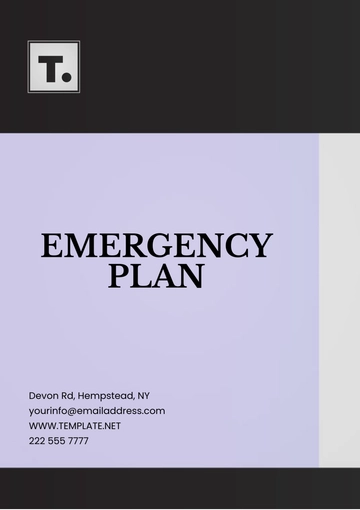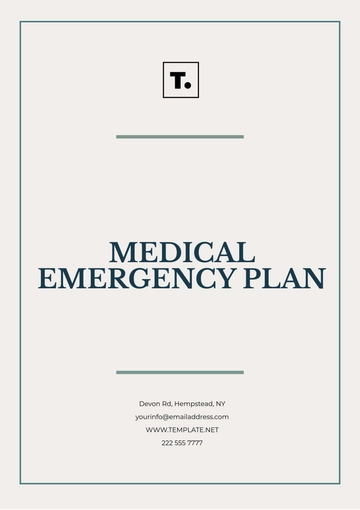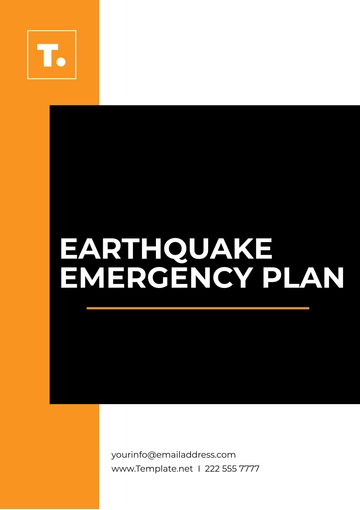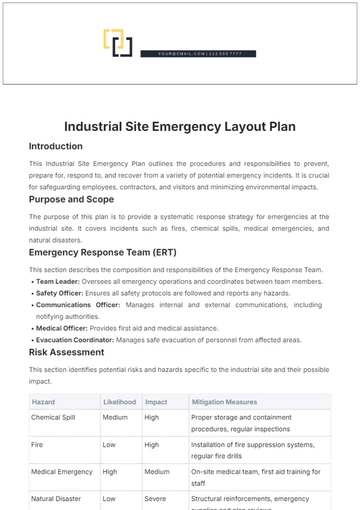Free Earthquake emergency plan

Introduction
This Earthquake Emergency Plan aims to ensure the safety and preparedness of individuals and organizations in the event of an earthquake. By following the detailed guidelines and procedures outlined in this plan, we aim to reduce injury, protect lives, and minimize property damage.
Preparedness Plan
Preparedness is crucial to effectively respond to an earthquake. The following steps should be taken in advance:
Identify safe spots in each room, such as under sturdy furniture or against interior walls away from windows.
Develop an evacuation plan and conduct regular drills to familiarize everyone with escape routes and procedures.
Prepare an emergency kit that includes water, non-perishable food, first aid supplies, a flashlight, batteries, and essential medications.
Secure heavy objects and fixtures, such as bookshelves and appliances, to prevent them from tipping over during an earthquake.
Review and update insurance policies, ensuring adequate coverage for potential earthquake-related damages.
Response Plan
In the event of an earthquake, the following actions should be taken immediately:
Drop, Cover, and Hold On: Drop to your hands and knees, cover your head and neck, and hold on to a stable piece of furniture until the shaking stops.
Stay Indoors: Remain indoors until the shaking stops and it is safe to evacuate. Avoid using elevators.
Avoid Hazards: Stay away from windows, mirrors, and heavy objects that may topple over.
Assist Others: Help those in need, including children, elderly, and disabled individuals, to get to safety.
Evacuate Safely: Once the shaking stops, follow designated evacuation routes to exit the building safely.
Communication Plan
Communication is vital during and after an earthquake. Ensure you have a plan in place to keep everyone informed:
Establish an emergency contact list, including phone numbers and email addresses of family members and key personnel.
Use text messaging or social media platforms to communicate, as phone lines may be congested.
Stay informed through official channels, such as local radio or television broadcasts, for updates and instructions.
Develop a system for accounting for all individuals, including a designated meeting point away from hazards.
Recovery Plan
After the earthquake, focus on recovery efforts to restore safety and normalcy:
Assess injuries and administer first aid. Seek professional medical assistance for serious injuries.
Inspect buildings for structural damages and evacuate if there is suspicion of danger.
Contact utility companies to report damage to water, gas, electric, and sewer lines.
Document and photograph any property damage for insurance purposes.
Provide emotional support and counseling to individuals affected by the earthquake.
Resources
Maintain a list of essential resources and contacts to support your emergency response:
Resource | Contact Information |
|---|---|
Local Emergency Services | [Phone Number] |
Red Cross | [Phone Number] |
Local Hospitals | [Phone Number] |
Insurance Provider | [Phone Number] |
Utility Companies | [Phone Number] |
Conclusion
Adhering to this Earthquake Emergency Plan will enhance safety, improve response times, and ensure effective recovery in the event of an earthquake. Regularly review and update this plan to accommodate changes and improvements in safety protocols.
- 100% Customizable, free editor
- Access 1 Million+ Templates, photo’s & graphics
- Download or share as a template
- Click and replace photos, graphics, text, backgrounds
- Resize, crop, AI write & more
- Access advanced editor
Prepare for the unexpected with the Earthquake Emergency Plan Template. This comprehensive and customizable resource allows you to create a tailored emergency response strategy for your household or organization. The downloadable and printable format ensures easy access during critical situations. Plus, it's editable in our AI Editor Tool for seamless modifications. Stay safe and organized, offered by Template.net.
You may also like
- Finance Plan
- Construction Plan
- Sales Plan
- Development Plan
- Career Plan
- Budget Plan
- HR Plan
- Education Plan
- Transition Plan
- Work Plan
- Training Plan
- Communication Plan
- Operation Plan
- Health And Safety Plan
- Strategy Plan
- Professional Development Plan
- Advertising Plan
- Risk Management Plan
- Restaurant Plan
- School Plan
- Nursing Home Patient Care Plan
- Nursing Care Plan
- Plan Event
- Startup Plan
- Social Media Plan
- Staffing Plan
- Annual Plan
- Content Plan
- Payment Plan
- Implementation Plan
- Hotel Plan
- Workout Plan
- Accounting Plan
- Campaign Plan
- Essay Plan
- 30 60 90 Day Plan
- Research Plan
- Recruitment Plan
- 90 Day Plan
- Quarterly Plan
- Emergency Plan
- 5 Year Plan
- Gym Plan
- Personal Plan
- IT and Software Plan
- Treatment Plan
- Real Estate Plan
- Law Firm Plan
- Healthcare Plan
- Improvement Plan
- Media Plan
- 5 Year Business Plan
- Learning Plan
- Marketing Campaign Plan
- Travel Agency Plan
- Cleaning Services Plan
- Interior Design Plan
- Performance Plan
- PR Plan
- Birth Plan
- Life Plan
- SEO Plan
- Disaster Recovery Plan
- Continuity Plan
- Launch Plan
- Legal Plan
- Behavior Plan
- Performance Improvement Plan
- Salon Plan
- Security Plan
- Security Management Plan
- Employee Development Plan
- Quality Plan
- Service Improvement Plan
- Growth Plan
- Incident Response Plan
- Basketball Plan
- Emergency Action Plan
- Product Launch Plan
- Spa Plan
- Employee Training Plan
- Data Analysis Plan
- Employee Action Plan
- Territory Plan
- Audit Plan
- Classroom Plan
- Activity Plan
- Parenting Plan
- Care Plan
- Project Execution Plan
- Exercise Plan
- Internship Plan
- Software Development Plan
- Continuous Improvement Plan
- Leave Plan
- 90 Day Sales Plan
- Advertising Agency Plan
- Employee Transition Plan
- Smart Action Plan
- Workplace Safety Plan
- Behavior Change Plan
- Contingency Plan
- Continuity of Operations Plan
- Health Plan
- Quality Control Plan
- Self Plan
- Sports Development Plan
- Change Management Plan
- Ecommerce Plan
- Personal Financial Plan
- Process Improvement Plan
- 30-60-90 Day Sales Plan
- Crisis Management Plan
- Engagement Plan
- Execution Plan
- Pandemic Plan
- Quality Assurance Plan
- Service Continuity Plan
- Agile Project Plan
- Fundraising Plan
- Job Transition Plan
- Asset Maintenance Plan
- Maintenance Plan
- Software Test Plan
- Staff Training and Development Plan
- 3 Year Plan
- Brand Activation Plan
- Release Plan
- Resource Plan
- Risk Mitigation Plan
- Teacher Plan
- 30 60 90 Day Plan for New Manager
- Food Safety Plan
- Food Truck Plan
- Hiring Plan
- Quality Management Plan
- Wellness Plan
- Behavior Intervention Plan
- Bonus Plan
- Investment Plan
- Maternity Leave Plan
- Pandemic Response Plan
- Succession Planning
- Coaching Plan
- Configuration Management Plan
- Remote Work Plan
- Self Care Plan
- Teaching Plan
- 100-Day Plan
- HACCP Plan
- Student Plan
- Sustainability Plan
- 30 60 90 Day Plan for Interview
- Access Plan
- Site Specific Safety Plan





























